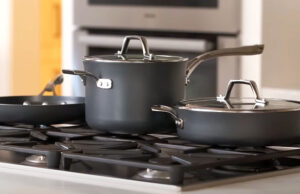As an Amazon Associate, I earn from qualifying purchases at no extra cost to you.
KitchenAid Dishwasher E4 F8 Error: Causes and Solutions
Dishwashers have become a household essential, making kitchen cleanup a breeze. But, like any appliance, they can occasionally experience problems. If you’ve encountered the KitchenAid dishwasher E4 F8 error code, you’re not alone. This error can leave you frustrated, but the good news is that it is often fixable.
In this blog post, we will dive deep into what this error code means, its possible causes, and how you can resolve it with a few simple steps. Whether you’re a DIY enthusiast or simply trying to understand what’s going wrong, we’ve got you covered.
What is the KitchenAid Dishwasher E4 F8 Error Code?
The E4 F8 error code in your KitchenAid dishwasher signals a problem that can disrupt the normal washing cycle. It’s important to understand that error codes are the dishwasher’s way of communicating a specific issue, often related to how the appliance is functioning.
In the case of the E4 F8 error, it typically points to an issue with the drainage system, specifically a drain pump problem. This problem can prevent the dishwasher from properly draining the water, which can lead to standing water inside the machine.
Before getting overwhelmed, it’s important to know that this issue can be resolved through simple troubleshooting. Let’s walk through the possible causes and solutions to get your dishwasher back in top shape.
Possible Causes of the KitchenAid Dishwasher E4 F8 Error Code
Understanding what causes the E4 F8 error code is the first step toward fixing it. There are several reasons why your dishwasher may display this code, ranging from simple blockages to more complicated mechanical issues. Let’s explore these causes in more detail.
Drain Pump Issues
The most common cause of the E4 F8 error code is a problem with the drain pump. This component is responsible for removing water from the dishwasher after the cleaning cycle. If the drain pump becomes clogged or defective, water may not be able to drain properly, causing the error to appear.
Clogged Drain Hose
A blocked drain hose is another frequent cause of the E4 F8 error. Over time, food particles, debris, or even soap scum can build up in the hose and restrict the flow of water. When this happens, the water may not drain efficiently, triggering the error code.
Faulty Drain Valve
The drain valve controls the flow of water from the dishwasher to the drain hose. If this valve becomes stuck or malfunctioning, it can cause water to remain in the machine, resulting in the E4 F8 error.
Problems with the Dishwasher’s Control Board
In rare cases, the issue may lie within the dishwasher’s control board. This electronic component controls various functions of the dishwasher, including the drainage process. If the control board fails to communicate properly with the drain pump or other parts, it can lead to the E4 F8 error.
Issues with the Air Gap
The air gap is a device that prevents dirty water from flowing back into the dishwasher. If it gets clogged or is improperly installed, it can cause drainage problems, leading to the E4 F8 error.
Understanding these common causes can help you focus your troubleshooting efforts. Now that we know what might be causing the problem, let’s explore how you can fix it.
How to Fix the KitchenAid Dishwasher E4 F8 Error Code
Once you’ve identified the potential causes of the E4 F8 error, it’s time to start troubleshooting. You don’t always need to call a repair technician right away; many issues can be fixed with a little elbow grease and a few simple tools. Below, we will guide you step-by-step on how to tackle each potential problem.
Step 1: Inspect the Drain Pump
The first step in resolving the E4 F8 error is to check the drain pump. Here’s how to do it:
- Locate the pump: The drain pump is typically located at the bottom of the dishwasher. You may need to remove the bottom rack to gain access to it.
- Check for obstructions: Use a flashlight to inspect the pump for any debris, food particles, or buildup that may be blocking the pump.
- Clean the pump: If you find any debris, carefully remove it. You can use a soft cloth or sponge to clean the area around the pump.
- Test the pump: After cleaning, check if the pump is working correctly by running a short cycle. If the dishwasher drains properly, the error should be gone.
Step 2: Clear the Drain Hose
If the pump appears to be fine, the next step is to check the drain hose. Follow these steps:
- Unclog the hose: Disconnect the hose from the dishwasher and inspect it for clogs. You can use a long, flexible brush to remove any buildup inside the hose.
- Flush the hose: Run water through the hose to ensure it’s clear. If the water doesn’t flow freely, there may still be a clog.
- Reattach the hose: Once the hose is clear, reconnect it to the dishwasher and check for leaks.
Step 3: Check the Drain Valve
The drain valve can also cause the E4 F8 error. Here’s how to check it:
- Locate the valve: The drain valve is usually located near the pump. Refer to your dishwasher’s user manual to find the exact location.
- Inspect for malfunctions: Check if the valve is stuck or damaged. If it’s stuck in the closed position, it can prevent water from draining.
- Clean or replace: If the valve is dirty, clean it with a soft cloth. If it appears damaged, you may need to replace it with a new one.
Step 4: Reset the Dishwasher
Sometimes, the E4 F8 error can be cleared by simply resetting the dishwasher. Here’s how you can reset it:
- Turn off the dishwasher: Press the power button to turn off the dishwasher.
- Unplug the appliance: Unplug the dishwasher from the power source and wait for about 5 minutes.
- Plug it back in: After waiting, plug the dishwasher back in and turn it on. Run a short cycle to see if the error persists.
Step 5: Inspect the Control Board
If none of the above steps work, the issue may be with the control board. This is a more complicated repair and might require professional assistance. However, if you’re comfortable, here’s how to inspect the control board:
- Turn off the power: Always disconnect the dishwasher from the power supply before inspecting internal components.
- Remove the panel: Use a screwdriver to remove the front panel of the dishwasher.
- Check the control board: Look for any visible signs of damage, such as burned components or loose wires. If you notice any issues, the control board may need to be replaced.
If you’re not comfortable handling electrical components, it’s best to contact a professional to diagnose and repair the control board.
Preventing Future E4 F8 Errors
While dealing with an E4 F8 error can be frustrating, taking steps to prevent future issues is key to keeping your dishwasher running smoothly. Here are some tips to help you avoid this error in the future.
Regularly Clean the Drain Pump and Hose
To avoid clogs, it’s important to clean the drain pump and hose regularly. You can do this by running a cleaning cycle with a dishwasher cleaner or by manually inspecting and clearing out any debris every few months.
Use a Dishwasher Cleaner
Using a dishwasher cleaner can help prevent buildup inside the machine. These cleaners remove grease, soap scum, and mineral deposits that can cause clogs in the drain system.
Don’t Overload the Dishwasher
Overloading the dishwasher can lead to drainage problems. Make sure you load your dishwasher according to the manufacturer’s instructions, leaving enough space for water to flow freely and rinse the dishes effectively.
Check the Air Gap
If your dishwasher has an air gap, be sure to check it regularly for clogs. You can clean the air gap by removing the cap and flushing it with water.
By following these simple tips, you can reduce the chances of encountering the E4 F8 error again.
I hope this guide has helped you understand the KitchenAid dishwasher E4 F8 error code and provided practical solutions to fix it. With a little effort, you can troubleshoot and resolve most of the issues causing the error. However, if you’re unsure about handling repairs, it’s always a good idea to consult a professional. Keep your dishwasher in good working condition, and you’ll continue to enjoy the convenience of having it clean your dishes effortlessly.
Frequently Asked Questions (FAQs)
Is it safe to fix the E4 F8 error on my own?
Yes, it is generally safe to fix the E4 F8 error on your own, as long as you take the necessary precautions. Ensure the dishwasher is unplugged, and always follow safety guidelines when working with electrical components. If you’re unsure, it’s best to seek professional help.
Can the E4 F8 error be caused by a power surge?
While a power surge can cause various issues with electronics, the E4 F8 error is typically related to drainage problems rather than power surges. However, if the control board has been damaged by a surge, it could be a contributing factor.
Do I need to replace the drain pump if it’s clogged?
In most cases, if the drain pump is clogged, cleaning it will resolve the issue. However, if the pump is damaged or continues to malfunction after cleaning, you may need to replace it.
Is there a way to prevent the E4 F8 error from happening again?
Yes, regularly cleaning the drain pump, drain hose, and air gap can help prevent clogs that lead to the E4 F8 error. Using a dishwasher cleaner can also help keep the system free from debris.
Can I use any type of drain cleaner to clear clogs?
It’s best to avoid harsh chemical drain cleaners, as they can damage the dishwasher’s components. Instead, use a gentle dishwasher cleaner or a natural solution like vinegar and baking soda to clear any blockages.
Do I need to call a professional if the E4 F8 error persists?
If you’ve followed all the troubleshooting steps and the error persists, it may be time to call a professional technician. Issues with the control board or pump may require expert attention.
Is the E4 F8 error covered under warranty?
If your dishwasher is still under warranty, the E4 F8 error may be covered, depending on the cause. Check your warranty terms to see if repairs are included.
Can overloading the dishwasher cause the E4 F8 error?
Yes, overloading the dishwasher can lead to drainage problems, as it may prevent water from draining properly. Always load your dishwasher according to the manufacturer’s guidelines to avoid issues.



